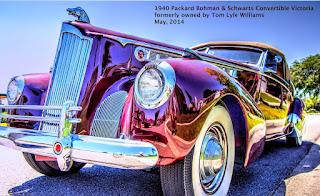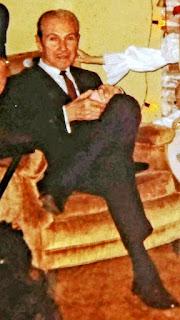
Gay Life in in Hollywood 1920s through 2022.
Sharrie Williams, Author of the Maybelline Story.

During the 1920s, also known as the "Roaring Twenties," there was a significant cultural shift in the United States and many other parts of the world. This was a time of great social and political change, and the gay community was no exception.
While homosexuality was still stigmatized and criminalized in many places during the 1920s, there were also some significant developments for the gay community. In particular, the 1920s saw the emergence of a visible and organized gay subculture in major cities such as New York, Paris, and Berlin.
In the United States, the 1920s marked the beginning of the "Harlem Renaissance," a period of great artistic and cultural flowering among African Americans in Harlem, New York. This was also a time of increased visibility and acceptance for the gay community in Harlem, as many LGBTQ+ people found a sense of belonging and support within the Harlem Renaissance's artistic and intellectual circles.
Despite this increased visibility and acceptance, however, homosexuality was still largely taboo and criminalized during the 1920s. Many LGBTQ+ people lived their lives in secret, and those who were open about their sexual orientation or gender identity often faced discrimination and persecution.
Overall, the 1920s were a time of great change and cultural upheaval for the LGBTQ+ community, with both challenges and opportunities.
Gay life in 1930s Hollywood

Tom Lyle Williams Christmas of 1967. Shortly after selling the Maybelline Co. To Plough Inc.
Life for gay people in 1930s Hollywood was likely very difficult, as homosexuality was not widely accepted or understood at the time. Many gay people in Hollywood during this period likely had to keep their sexual orientation hidden in order to protect their careers and personal lives. There were no openly gay celebrities in Hollywood during the 1930s, and it was common for gay people in the entertainment industry to be closeted for fear of being ostracized or discriminated against. This often meant leading a double life, as many gay people in Hollywood during this time were forced to marry people of the opposite sex in order to maintain the appearance of conformity.
Hollywood in the 1940s was a difficult place for gay men and women. The film industry was extremely homophobic, and many people in the industry remained in the closet for fear of being ostracized or losing their careers. It was a time when homosexuality was heavily stigmatized and discriminated against, and there was a great deal of fear and misunderstanding about it. Many gay people in Hollywood lived secret lives and kept their sexuality hidden from the public. It was not uncommon for studios to insist that actors and actresses hide their homosexuality or face blacklisting. Despite the difficulties, there were a few openly gay people in Hollywood during this time, including actresses Tallulah Bankhead and Alla Nazimova, and actor William Haines.
Conditions for gay people in Hollywood did not improve significantly in the 1950s. Homophobia and discrimination were still widespread, and many gay people in the film industry continued to hide their sexuality for fear of losing their careers. In the 1950s, the Hollywood blacklist was in effect, and many people in the film industry were accused of being communists or having communist sympathies. This blacklist also targeted gay people, and many were blacklisted or forced to leave the industry because of their sexuality. Despite the challenges, there were a few openly gay people in Hollywood during this time, including actors Rock Hudson and Montgomery Clift, and director James Whale.
The 1960s were a time of significant social and cultural change, and this included greater acceptance of homosexuality. However, gay people in the United States still faced a great deal of discrimination and legal challenges. Homosexuality was classified as a mental illness by the American Psychiatric Association until 1973, and many states had laws that criminalized homosexuality. In Hollywood, gay people were still largely closeted, and there was a great deal of fear and stigma surrounding homosexuality in the film industry. Despite these challenges, the 1960s were also a time of growing visibility and activism for the gay rights movement. The Stonewall riots in 1969, in which gay people fought back against police harassment at a gay bar in New York City, are widely considered to be the beginning of the modern gay rights movement.
The 1970s were a time of significant social and cultural change, and this was especially true in Hollywood. While the film industry has always been home to a diverse range of people, the 1970s saw the emergence of a visible and influential gay community in Hollywood.
During this time, many gay actors, writers, and other industry professionals were able to be more open about their sexual orientation than ever before. This was due in part to the increasing acceptance of LGBTQ+ people in mainstream society, as well as to the efforts of gay rights activists who worked to promote visibility and acceptance.
However, it was still a difficult time for many LGBTQ+ people in Hollywood and beyond. Homosexuality was only fully legalized in the United States in 2003, and many gay people faced discrimination, marginalization, and even violence.
Despite these challenges, the gay community in Hollywood played a vital role in shaping the cultural landscape of the 1970s and beyond. Through their work in film, television, and other media, they helped to bring LGBTQ+ issues to the forefront of public consciousness and worked to create a more inclusive and accepting society.
The 1980s were a time of significant change for the gay community in Hollywood and beyond. While the 1970s had seen the emergence of a visible and influential gay community in the film industry, the 1980s saw the continuation of this trend and the growth of a more vocal and activist gay community.
During this time, many gay actors, writers, and other industry professionals were able to be more open about their sexual orientation than ever before, and there were a number of high-profile individuals who came out publicly during this decade. This increased visibility helped to promote greater understanding and acceptance of LGBTQ+ people, and many gay rights organizations were founded or gained greater prominence during this time.
However, the 1980s were also a time of significant challenges for the gay community. The HIV/AIDS crisis, which began in the 1970s, continued to have a devastating impact on the gay community, and many people lost their lives to the disease. In addition, LGBTQ+ people continued to face discrimination, marginalization, and violence, and there were several instances of violent attacks against gay individuals during this decade.
Despite these challenges, the gay community in Hollywood continued to thrive and make a significant impact on the cultural landscape of the 1980s. Through their work in film, television, and other media, they helped to bring LGBTQ+ issues to the forefront of public consciousness and worked to create a more inclusive and accepting society.
The 1990s were a time of significant change for the gay community in Hollywood and beyond. While the 1980s had seen the continuation of the trend of increased visibility and activism among LGBTQ+ people, the 1990s saw the further growth of a more vocal and politically active gay community.
During this time, many gay actors, writers, and other industry professionals were able to be more open about their sexual orientation than ever before, and there were a number of high-profile individuals who came out publicly during this decade. This increased visibility helped to promote greater understanding and acceptance of LGBTQ+ people, and many gay rights organizations continued to work towards equality and acceptance.
In addition, the 1990s saw a number of significant legal and political victories for the gay community. The "Don't Ask, Don't Tell" policy, which had prohibited openly gay individuals from serving in the military, was repealed in 2011, and the Defense of Marriage Act, which had defined marriage as between a man and a woman, was struck down in 2015.
Despite these victories, the gay community in Hollywood and beyond continued to face significant challenges. The HIV/AIDS crisis, which had had a devastating impact on the community in the 1980s, continued to be a major issue, and LGBTQ+ people continued to face discrimination and violence.
Overall, the 1990s were a time of significant progress for the gay community in Hollywood and beyond, as they worked towards greater acceptance and equality
The 2000s were a time of significant progress for the gay community in Hollywood and beyond. While the 1990s had seen the growth of a more vocal and politically active gay community, the 2000s saw the continuation of this trend and the further advancement of LGBTQ+ rights.
Hollywood Gay life in the 21 Century
During this time, many gay actors, writers, and other industry professionals were able to be more open about their sexual orientation than ever before, and there were a number of high-profile individuals who came out publicly during this decade. This increased visibility helped to promote greater understanding and acceptance of LGBTQ+ people, and many gay rights organizations continued to work towards equality and acceptance.
In addition, the 2000s saw a number of significant legal and political victories for the gay community. The "Don't Ask, Don't Tell" policy, which had prohibited openly gay individuals from serving in the military, was repealed in 2011, and the Defense of Marriage Act, which had defined marriage as between a man and a woman, was struck down in 2015. These and other victories helped to create a more inclusive and equal society for LGBTQ+ people.
Despite these victories, the gay community in Hollywood and beyond continued to face challenges. LGBTQ+ people continued to experience discrimination and violence, and the HIV/AIDS crisis remained a significant issue.
Overall, the 2000s were a time of significant progress for the gay community in Hollywood and beyond, as they worked towards greater acceptance and equality.
